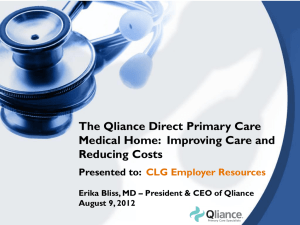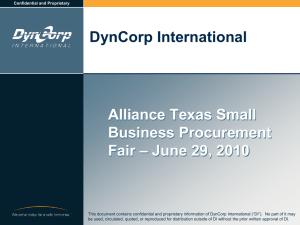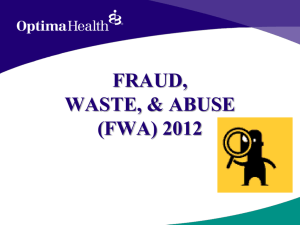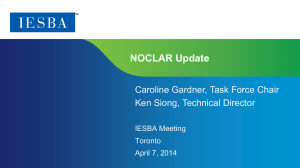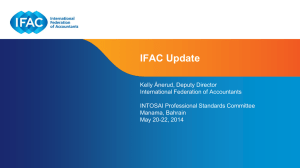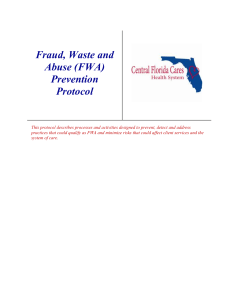OHBS Fraud, Waste and Abuse PowerPoint - April
advertisement
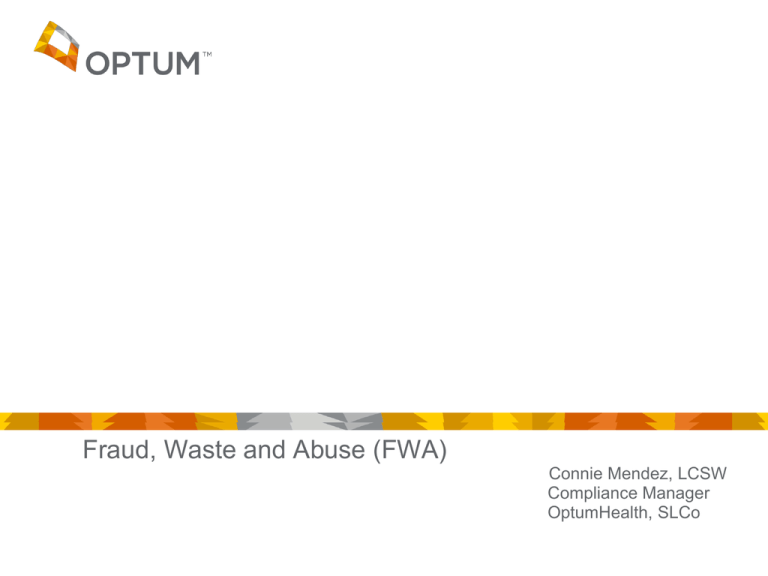
Fraud, Waste and Abuse (FWA) Connie Mendez, LCSW Compliance Manager OptumHealth, SLCo What is Fraud, Waste and Abuse (FWA)? Fraud Waste Abuse Intentional misrepresentation to gain a benefit Any unnecessary consumption of health care resources Unsound business practice that results in undue remuneration • U.S. health care spending growth decelerated in 2009, increasing 4.0% compared to 4.7% in 2008. Total health expenditures reached $2.5 trillion*, which translates to $8,086 per person or 17.6% of the nation’s GDP, up from 16.6% in 2008.* • Conservatively it is estimated that 3% to 10% of all health care dollars are spent on Fraud, Waste or Abuse annually according to the National Health Care Anti-Fraud Association (NHCAA). Which correlates to between 70B and 250B annually. * NHE cited by https://cms.gov/NationalHealthExpendData/downloads/tables.pdf Proprietary and Confidential. Do not distribute. 2 What’s driving FWA initiatives • State and national hot button • Full partnership and collaboration with state and federal partners • OHBS commitment • Enhancing our pre-payment intervention • Strengthening post-payment detection • Investigations and retro-recovery • Corrective action “ We can’t solve problems by using the same kind of thinking we used when we created them.” Albert Einstein Proprietary and Confidential. Do not distribute. 3 Where do leads come from? Phone Email Mail Data mining Internal process review Audits Proprietary and Confidential. Do not distribute. 4 Who done it? • Consumers • Family members of consumers • Providers • Independent physician associations “Fraud is committed by health care providers, owners of medical facilities and laboratories, suppliers of medical equipment, organized crime groups, corporations, and even sometimes by the beneficiaries themselves.” Federal Bureau of Investigation (FBI) • Billing companies • Pharmaceutical companies Where is FWA Generally Most Prevalent? • Sales agents • Organized crime • Health plans • International interests • Opportunists Source: http://www.fbi.gov/news/stories/2010/june/health-care-fraud/health-care-trends Proprietary and Confidential. Do not distribute. 5 Pop quiz Health care Fraud, Waste and Abuse may be attributed to approximately __% of the nation’s gross domestic product. A. 0.1% B. 1% C. 10% $125 billion (EFWA) $2.5 trillion (NHE) = 0.9% of GDP Proprietary and Confidential. Do not distribute. 6 Pop quiz Health care Fraud, Waste and Abuse may be attributed to approximately __% of the nation’s gross domestic product. A. 0.1% B. 1% C. 10% B. 1% National health care expenditure (NHE) is $2.5 trillion annually1. Using 5%2 estimated Fraud, Waste or Abuse (EFWA), our country’s estimated FWA is $125 billion per year. $125 billion (EFWA) = 0.9% of GDP $2.5 trillion (NHE) 1 NHE cited by https://cms.gov/NationalHealthExpendData/downloads/tables.pdf 2 The National Health Care Anti-Fraud Association (NHCAA) estimates conservatively that 3% to 10% of all health care spending is fraud, waste or abuse (FWA). Proprietary and Confidential. Do not distribute. 7 22 Common behavioral health-specific FWA allegations 1. 2. 3. 4. 5. 6. 7. Up-coding Unbundling Misuse of modifiers Two-tier billing Services not rendered Excessive units/visits Multiple family members on one day 8. Billing under another provider’s ID number/TIN/NPI 9. Over utilization and medical necessity 10. Billing HCPCS units against CPT codes 11. Non-licensed professionals providing services 12. Inpatient fraud 13. Billing for member cancellations and no-shows 14. Falsifying clinical notes/forgery 15. Billing for excessive numbers of patients in one day 16. Billing beyond benefit limits 17. Balance billing 18. Office associates defrauding the provider 19. Theft of ID/services 20. Pharmacy/doctor shopping 21. Member kickback 22. Member reimbursement Proprietary and Confidential. Do not distribute. 8 Up-coding example Physician consistently bills for CPT 90807 (individual psychotherapy, ~45 to 50 minutes, with medical evaluation and management services), when in actuality, the physician normally spends 20–25 minutes with his patients. The proper code in the example above (a visit that includes therapy and medication management) is 90805 (individual psychotherapy, ~20 to 30 minutes with medical evaluation and management services). By selecting the 90807, the physician has ‘up’-coded the service and gains a higher reimbursement; this is an all too common issue. • Fictional case study. For educational purposes only. Proprietary and Confidential. Do not distribute. 9 Pharmacy/doctor shopping (member fraud) A member, Mr. Jones, goes to three separate psychiatrists. To each, Mr. Jones reports he had a previous diagnosis of Attention Deficit/Hyperactivity Disorder (ADHD) and required Ritalin (a stimulant often sold on the streets). He also reports symptoms of an anxiety disorder in an attempt to receive a prescription for a benzodiazepine, a sedative class that includes Valium, Xanax, Ativan, etc. (Benzodiazepines are highly addictive and are also frequently sold on the streets). If this member gets his way, he might have three separate psychiatrists prescribe multiple medications of the same type. • Fictional case study. For educational purposes only. Proprietary and Confidential. Do not distribute. 10 Our Commitment Our Mission We will expand and enhance our current Fraud, Waste and Abuse (FWA) program by: • bolstering our expertise • leveraging cutting-edge technology • fostering robust partnerships to create industry leading anti-FWA practices for each component of our program. • To protect our consumers, providers, business partners, employees and stakeholders by administering a strong and effective anti-Fraud, Waste and Abuse (FWA) program designed to prevent, detect, investigate and resolve incidents of potential FWA • To address and correct known offenses, recovering lost funds, improving overall antiFWA ability and partnering with state and federal agencies to pursue and prosecute violators to the fullest extent of the law Proprietary and Confidential. Do not distribute. 11 What is a Special Investigations Unit (SIU)? • A dedicated group responsible for driving the anti-FWA program. This group consists of highly skilled and trained investigators, clinicians, data analysts and medical coding personnel. • The OHBS SIU consists of three main investigative pathways: Pre-payment analytics Post-payment analytics • Analyze member, provider and claims data • Analyze member, provider and claims data • Identify trends, current/ upcoming schemes or unusual behavior • Identify trends, schemes or unusual behavior, then investigate • Stop fraudulent claims from being paid • Work with state and federal agencies to stop fraud, waste and abuse consistently across the industry Intelligence • Anonymous TIP line • Email • PO box • Internal and external training • State of the art detection systems and processes • Information sharing Proprietary and Confidential. Do not distribute. 12 Example Flag That Triggers SIU Intervention; Up-Coding • Peer profiling anomalies – Unusually high usage of higher intensity CPT or HCPCS codes • A couple examples specific to code range 90804-90809 – An extreme example would be billing 100% 90809s; notice the norm in this example is .05% on the curve, thus 100% would be 99.5% outside the norm – A more subtle example would be billing 60% 90807s and 40% 90806s; although not as extreme this would clearly be outside the norm as in this example 90807s are billed 3.4% of the time Example Fictitious Bell Curve 2008-2010 90804 90805 90806 90807 90808 90809 90862 583 14672 98690 4171 453 61 4717 0.5% 11.9% 80.0% 3.4% 0.4% 0.05% 3.8% Proprietary and Confidential. Do not distribute. 13 Potential Overutilization Example CPT code 90801, Psychiatric diagnostic interview examination: • Please refer to the most current CPT description; This procedure is described as the elicitation of a complete history, establishment of tentative diagnosis, and an evaluation of the patient’s ability and willingness to work to solve the patient’s mental problem. Generally billed once per year, per provider, unless a new condition arises. Member ID 90801 Norm PMPY Variance Larry 40 1.23 38.77 Mo 6 1.23 4.77 Curly 5 1.23 3.77 Proprietary and Confidential. Do not distribute. 14 Overutilization or Services Not Rendered? • In this example a 90801 Psychiatric diagnostic interview examination being billed for every visit even though the 90801 should only be used for an initial assessment. Proprietary and Confidential. Do not distribute. Excessive Charges This is an example of an out of network facility provider submitting a bill with a daily room and board charge of $18,000.00 Total charge for 17 days: $316,723.60 *Copy and paste this text box to enter notations/source information. 7pt type. Aligned to bottom. No need to move or resize this box. Proprietary and Confidential. Do not distribute. OHBS FWA Definitions • Suspicion: A level of suspicion is reached when potential fraud, waste, and abuse allegations cannot be ruled out by due diligence, data analysis and other preliminary investigative activities. • Confirmation: A level of confirmation is reached when fraud, waste, and abuse allegations have been substantiated during or at the conclusion of an SIU investigation. Proprietary and Confidential. Do not distribute. 17 Potential actions following audits All actions are reported to state and federal agencies Education and/or corrective action plans • Clarity on issue with guidance on how to correct, and/or • Formal plan to resolve and monitor moving forward Network termination • Termination for cause, termination for no cause, and/or • Reporting to National Practitioners Data Base (NPDB), state boards Request for overpayment, education and/or corrective action • Recovery of identified overpayment, and • Clarity on issue with guidance on how to correct, and/or • Formal plan to resolve and monitor moving forward Civil and/or criminal action • Health plan civil action does not preclude state/federal criminal enforcement • Expansive laws and enforcement options: civil monetary penalties, false claims, mail and/or wire fraud, anti-kickback, STARK, program exclusion, loss of license Proprietary and Confidential. Do not distribute. 18 Salt Lake County Requirements Proprietary and Confidential. Do not distribute. 19 Utah Code • Duty to report potential Medicaid fraud to the office or fraud unit. – 63J-4a-501. Duty to report potential Medicaid fraud to the office or fraud unit. (1) A health care professional, a provider, or a state or local government official or employee who becomes aware of fraud, waste, or abuse shall report the fraud, waste, or abuse to the office or the fraud unit. (2) A person who makes a report under Subsection (1) may request that the person's name not be released in connection with the investigation. (3) If a request is made under Subsection (2), the person's identity may not be released to any person or entity other than the office, the fraud unit, or law enforcement, unless a court of competent jurisdiction orders that the person's identity be released. Proprietary and Confidential. Do not distribute. To Report to Salt Lake County: • Contact Persons: Tim Whalen, Director Brian Currie, Mental Health Quality Assurance Address: Salt Lake County Division of Behavioral Health Services 2001 South State Street, S2300 Salt Lake City, UT 841090-2250 Phone: 801.468.2009 Fax: 801.468-2006 Proprietary and Confidential. Do not distribute. To Report Suspected FWA, contact the following: OptumHealth SLCo: Utah Medicaid Program Integrity: Telephone: 877-370-8953 Web-site: E-Mail: connie.mendez@optum.com http://health.utah.gov/mpi/reportfraud.html Mail: Compliance Manager 2525 Lake Park Blvd West Valley, UT 84130-0535 Telephone: 1-855-403-7283 E-Mail: mpi@utah.gov Fax: 248-733-6379 Thank You


